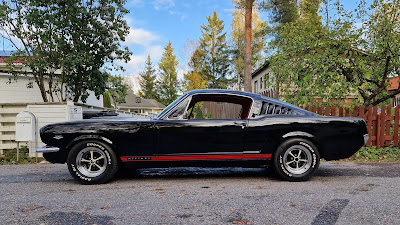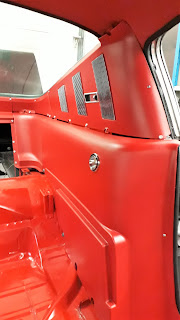Snowback had a set of wrong type and size of wheels when it came to my possession. As they were rather good they remained but as the time went on they started to bother me more and more as they did not perfectly match the looks that I want to have. It came with quite new 205/75-14 tires on '68-'69 type Styled Steel Wheels for which I managed to purchase a set of GT type hubcaps. The tires looked to big in diameter and too narrow. In my opinion the best looking rims for '65-'66 fastbacks are the Magnum 500's which were available as an option in 1966 and were the original wheels on Hertz Rent-a-Racers. Magnums are available as repros from a selection of vendors but although they look good in sizes of 14" to 16" they are of aluminum which makes them look too modern and they are costly, over 300 € each.
So, when I saw a set of 14" steel Magnums manufactured by Ford for sale at internet marketplace, I made a quick decision and purchased them. I consider them 'period correct' for my fastback. They were not in the perfect condition, but with some TLC they would do alright. I repainted the black areas and polished the chrome.
 |
| Checking the fit with worn out Cooper Cobras |
The Magnums came with a worn out and mixed set of BF Goodrich (225/60R14) and Cooper Cobras (215/70R70). BFG offers a wide range of tires as Cooper's offering is more limited. I had to have them with RWL (Raised White Letters). BFG is a lot more expensive so I wanted to verify whether the Coopers would be good enough, especially when it comes to fit for the purpose. There are many opinions which of these are better handling wheels, but I made the decision only based on the price (which for Coopers is only about a half of BFGs) and the looks. I placed an order for a set of Cooper Cobra 215/70R14 and couple of weeks later they arrived. Like so many American branded goods these are not manufactured in the US but Hecho en Mexico. More to come when the springtime allows to finally drive them.


















































